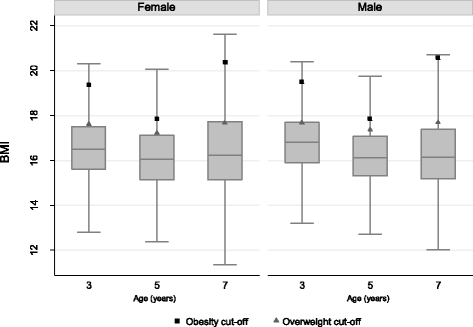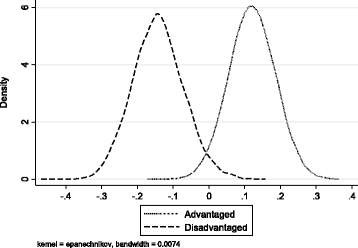Family lifestyle dynamics and childhood obesity: evidence from the millennium cohort study
- PMID: 29807535
- PMCID: PMC5971431
- DOI: 10.1186/s12889-018-5398-5
Family lifestyle dynamics and childhood obesity: evidence from the millennium cohort study
Abstract
Background: The prevalence of childhood obesity has been increasing but the causes are not fully understood. Recent public health interventions and guidance aiming to reduce childhood obesity have focused on the whole family, as opposed to just the child but there remains a lack of empirical evidence examining this relationship.
Methods: Using data from the longitudinal Millennium Cohort Study (MCS), we investigate the dynamic relationship between underlying family lifestyle and childhood obesity during early childhood. The MCS interviewed parents shortly after the birth of their child and follow up interviews were carried out when the child was 3, 5 and 7 years. We use a dynamic latent factor model, an approach that allows us to identify family lifestyle, its evolution over time (in this case between birth and 7 years) and its influence on childhood obesity and other observable outcomes.
Results: We find that family lifestyle is persistent, 87.43% of families which were above the 95th percentile on the lifestyle distribution, remained above the 95th percentile when the child was 7 years old. Family lifestyle has a significant influence on all outcomes in the study, including diet, exercise and parental weight status; family lifestyle accounts for 11.3% of the variation in child weight by age 7 years.
Conclusion: The analysis suggests that interventions should therefore be prolonged and persuasive and target the underlying lifestyle of a family as early as possible during childhood in order to have the greatest cumulative influence. Our results suggest that children from advantaged backgrounds are more likely to be exposed to healthier lifestyles and that this leads to inequalities in the prevalence of obesity. To reduce inequalities in childhood obesity, policy makers should target disadvantaged families and design interventions specifically for these families.
Keywords: Childhood obesity; Dynamic latent factor model; Family lifestyle.
Conflict of interest statement
Ethics approval and consent to participate
Ethics approval and participant consent was not necessary as this study involved the use of a previously-published de-identified database held by the UK data archive.
Competing interests
The authors declare that they have no competing interests.
Publisher’s Note
Springer Nature remains neutral with regard to jurisdictional claims in published maps and institutional affiliations.
Figures


Similar articles
-
Self-regulation and household routines at age three and obesity at age eleven: longitudinal analysis of the UK Millennium Cohort Study.Int J Obes (Lond). 2017 Oct;41(10):1459-1466. doi: 10.1038/ijo.2017.94. Epub 2017 Apr 24. Int J Obes (Lond). 2017. PMID: 28435162 Free PMC article.
-
Have health inequalities changed during childhood in the New Labour generation? Findings from the UK Millennium Cohort Study.BMJ Open. 2017 Jan 11;7(1):e012868. doi: 10.1136/bmjopen-2016-012868. BMJ Open. 2017. PMID: 28077409 Free PMC article.
-
The Fit Family Challenge: A Primary Care Childhood Obesity Pilot Intervention.J Am Board Fam Med. 2016 Jul-Aug;29(4):434-43. doi: 10.3122/jabfm.2016.04.150238. J Am Board Fam Med. 2016. PMID: 27390374
-
Offspring body size and metabolic profile - effects of lifestyle intervention in obese pregnant women.Dan Med J. 2014 Jul;61(7):B4893. Dan Med J. 2014. PMID: 25123127 Review.
-
Common approach to childhood obesity in Japan.J Pediatr Endocrinol Metab. 2014 Jul;27(7-8):581-92. doi: 10.1515/jpem-2014-0047. J Pediatr Endocrinol Metab. 2014. PMID: 24810559 Review.
Cited by
-
Concerns of parents about children's overweight and obesity during the COVID-19 pandemic: A qualitative study.J Pediatr Nurs. 2022 Mar-Apr;63:111-116. doi: 10.1016/j.pedn.2021.11.012. Epub 2021 Nov 17. J Pediatr Nurs. 2022. PMID: 34801324 Free PMC article.
-
Applications of artificial intelligence in the management of childhood obesity.J Family Med Prim Care. 2023 Nov;12(11):2558-2564. doi: 10.4103/jfmpc.jfmpc_469_23. Epub 2023 Nov 21. J Family Med Prim Care. 2023. PMID: 38186810 Free PMC article. Review.
-
Secular Changes in Body Build and Body Composition in Czech Preschool Children in the Context of Latent Obesity.Children (Basel). 2020 Dec 31;8(1):18. doi: 10.3390/children8010018. Children (Basel). 2020. PMID: 33396305 Free PMC article.
-
Caesarean section delivery and childhood obesity in a British longitudinal cohort study.PLoS One. 2019 Oct 30;14(10):e0223856. doi: 10.1371/journal.pone.0223856. eCollection 2019. PLoS One. 2019. PMID: 31665164 Free PMC article.
-
Prevalence and correlates of overweight and obesity among under-five children in Egypt.Front Public Health. 2022 Dec 14;10:1067522. doi: 10.3389/fpubh.2022.1067522. eCollection 2022. Front Public Health. 2022. PMID: 36589948 Free PMC article.
References
-
- Health Survey for England. 2012 Trend Tables: Child Trend Tables. 2013. Available from: www.hscic.gov.uk/pubs/hse2012trend. Accessed 9 Nov 2011.
-
- DH. Change4Life marketing strategy. In: Support of ealthy weight, healthy lives. London: Department of Health; 2009.
-
- NICE. NICE Public Health Guidance 11: Maternal and Child Nutrition [Internet]. London: National Institute for Health and Care Excellence (NICE): National Institute for Health and Care Excellence (NICE); 2008. Available from: http://guidance.nice.org.uk/PH11. Cited 16 Nov 2011.
-
- NICE . NICE public health guidance 27: dietary interventions and physical activity interventions for weight management before, during and after pregnancy. London: National Institute for Health and Care Excellence (NICE); 2010.
-
- NICE . NICE clinical guideline 43: obesity guidance on the prevention, identification, assessment and management of overweight and obesity in adults and children. London: National Institute for Health and Care Excellence (NICE); 2006. - PubMed
MeSH terms
Grants and funding
LinkOut - more resources
Full Text Sources
Other Literature Sources
Medical

